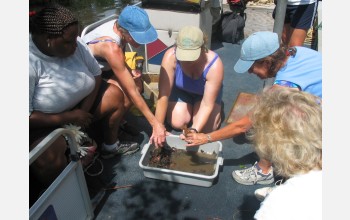|

Press Release 06-001
New NSF Centers Encourage Collaboration Between Ocean Scientists, Educators

January 3, 2006
The National Science Foundation (NSF) has awarded three new grants in its Centers for Ocean Science Education Excellence (COSEE) program, bringing the total number of the centers to 10. Each new COSEE will receive $2.5 million over five years.
The effort is designed to integrate ocean-science research into delivery of high-quality education programs in the ocean sciences, and to promote a deeper public understanding of the oceans and their influence on quality of life and national prosperity.
Each COSEE partnership is intended to foster interactions among ocean research institutions, formal education organizations and informal education providers like museums. The three new centers include themes of connecting inland populations and freshwater systems with the oceans and creating ocean learning communities.
The new centers are the COSEE Great Lakes (University of Michigan and others); COSEE Ocean Systems (Bigelow Laboratory for Ocean Sciences in Maine, and others); and COSEE Ocean Learning Communities (University of Washington, Seattle, and others). NOAA Sea Grant is contributing approximately 50 percent of the funding for the COSEE Great Lakes.
"The COSEE network promotes a better understanding of the key role the ocean plays in global environmental cycles and processes," said Larry Clark, acting director of NSF's Division of Ocean Sciences. "COSEE activities highlight the contributions ocean-science researchers make to scientific knowledge in these important areas. NSF is encouraging the ocean-science research community to become more involved in education at all levels. The establishment of these centers is an important milestone."
Existing centers are COSEE California; COSEE Florida; COSEE Central Gulf of Mexico; COSEE Mid-Atlantic; COSEE New England; COSEE South East; and COSEE West. The Consortium for Oceanographic Research and Education (CORE) in Washington, D.C. coordinates the network and promotes the program, including outreach to professional societies and organizations.
Each COSEE represents one or more ocean science research institution, an informal science education organization, and at least one affiliate organization representing the formal education community.
Center activities include:
- establishing links between people and organizations conducting ocean-science research and those providing educational leadership or outreach among diverse communities
- providing expertise and guidance for research scientists involved in education, such as conducting workshops to encourage scientists to develop collaborative grant proposals with educators or to experiment with various education and teaching strategies
- providing incentives and assistance for school districts and teachers to integrate ocean sciences into their curricula
- facilitating the integration of research results into high-quality educational materials, as well as fostering the development and dissemination of those materials both regionally and nationally
The COSEE network is coordinating ocean-science education on a national level. COSEEs have, for example, contributed to developing a national framework for ocean literacy, guided scientists on how to engage in education and public outreach, and contributed to a course on communicating about ocean sciences.
In addition, said Clark, COSEE centers ensure that groups underrepresented in the ocean sciences have improved access to ocean-science education and research results. "Historically, the field of oceanography has not attracted a diverse set of students, and only limited progress has been made in the past decade. COSEEs make a concerted effort to include underrepresented groups in both formal and informal educational activities about the oceans."
-NSF-

Media Contacts
Cheryl Dybas, NSF (703) 292-7734 cdybas@nsf.gov
Tomeka Rawlings, CORE (202) 332-0063 trawlings@coreocean.org
Related Websites
COSEE: http://www.cosee.net/

The National Science Foundation (NSF) is an independent federal agency that supports fundamental research and education across all fields of science and engineering. In fiscal year (FY) 2009, its budget is $9.5 billion, which includes $3.0 billion provided through the American Recovery and Reinvestment Act. NSF funds reach all 50 states through grants to over 1,900 universities and institutions. Each year, NSF receives about 44,400 competitive requests for funding, and makes over 11,500 new funding awards. NSF also awards over $400 million in professional and service contracts yearly.
 Get News Updates by Email Get News Updates by Email
Useful NSF Web Sites:
NSF Home Page: http://www.nsf.gov
NSF News: http://www.nsf.gov/news/
For the News Media: http://www.nsf.gov/news/newsroom.jsp
Science and Engineering Statistics: http://www.nsf.gov/statistics/
Awards Searches: http://www.nsf.gov/awardsearch/
| 

